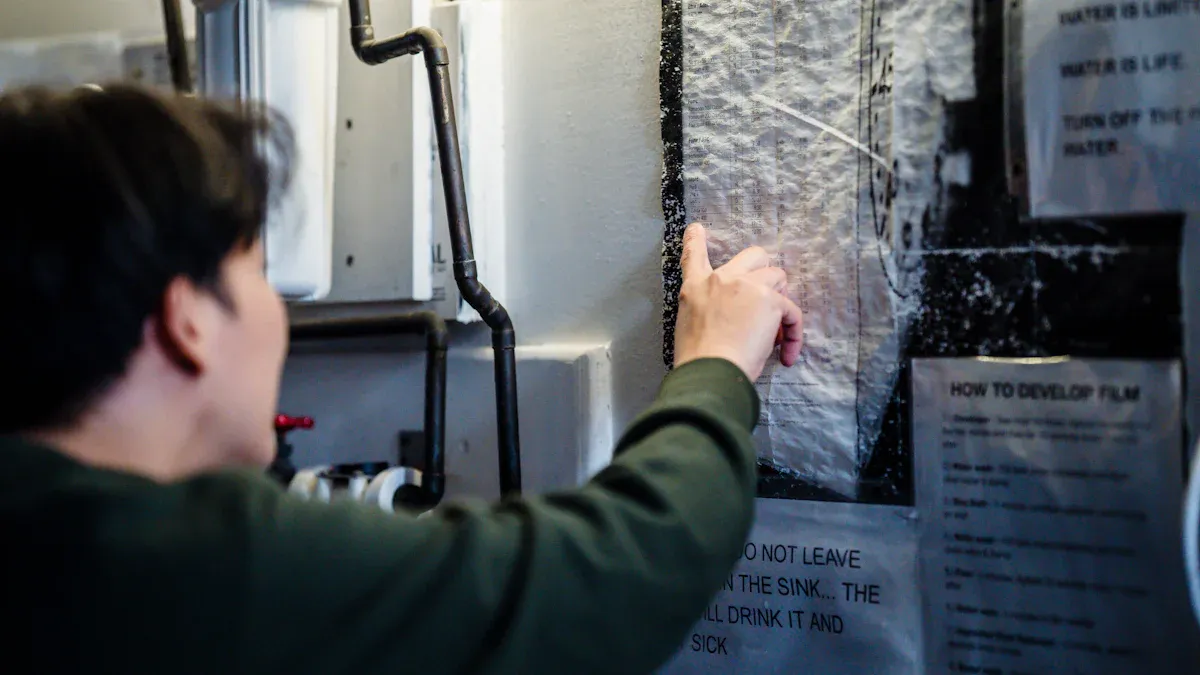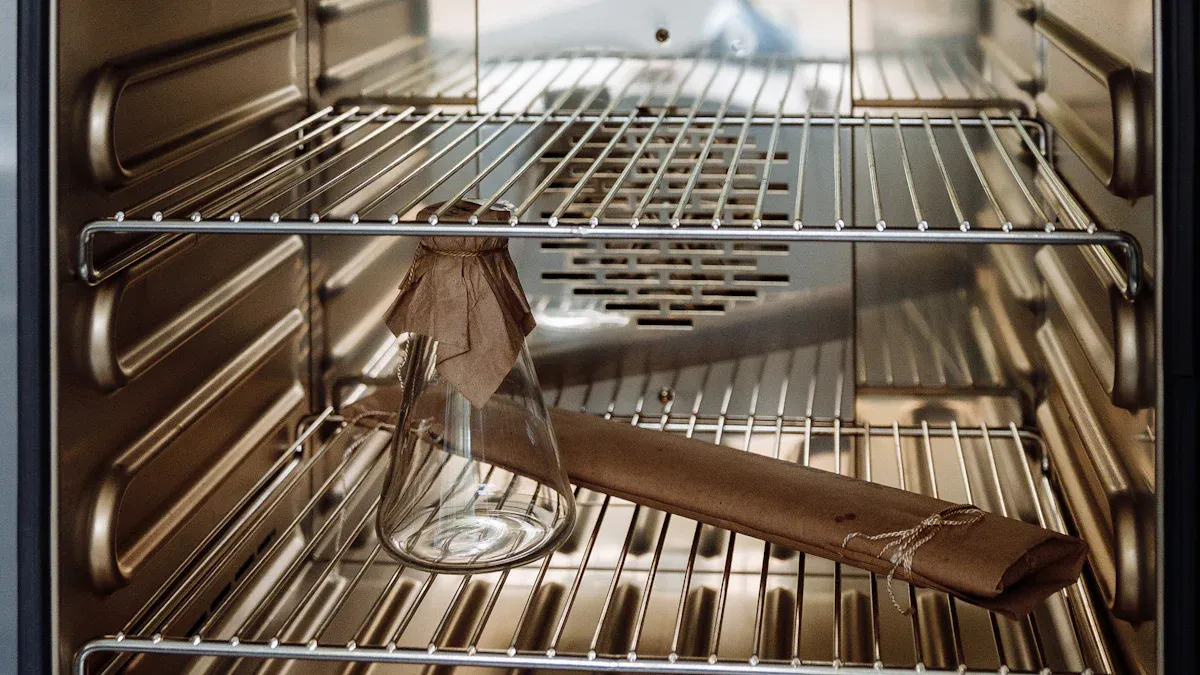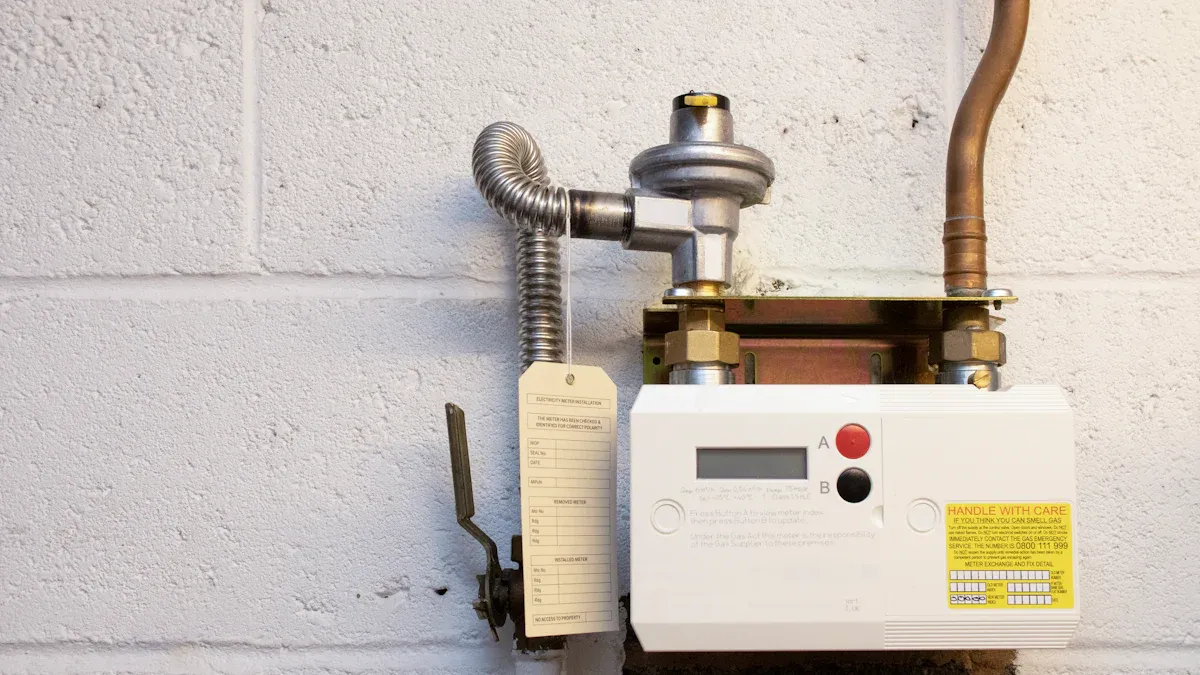
You can maximize the efficiency of your water heater by focusing on the proper care of its élément chauffant. Regular upkeep helps you avoid unnecessary energy costs and ensures your éléments chauffants pour appareils ménagers remain reliable. Many Fabricants d'éléments chauffants, y compris Chauffage électrique Jinzhong, recommend routine checks because advanced technologies like self-cleaning elements reduce scale buildup and extend service life.
- Regular maintenance with corrosion-resistant materials increases the lifespan of your heating element.
- Predictive maintenance features in modern units can lower service costs and minimize downtime.
| Inspection Frequency | Recommendation |
|---|---|
| Annual Inspection | Recommended for all water heaters to identify potential issues early. |
| Tankless Water Heaters | Should be inspected annually, following manufacturer’s recommendations. |
| Hard Water Areas | Inspections may be needed every 6 to 9 months to prevent sediment buildup. |
| Older Water Heaters | Should be inspected every 6 months if nearing the end of lifespan (10-15 years). |
| Visible Problems | Immediate inspection is necessary if leaks, rust, or inconsistent hot water is noticed. |
| DIY Maintenance | Flushing the tank may be needed every 6 to 12 months depending on water quality. |
Water Heater Element Maintenance Essentials
Key Reasons for Regular Maintenance
Lowering Energy Costs
You can reduce your monthly utility bills by performing regular maintenance on your water heater element. When you keep the element clean and free of mineral deposits, the system heats water more efficiently. Sediment and scale buildup force the element to work harder, which increases energy consumption.
Conseil : Periodic cleaning and descaling not only improve energy efficiency but also extend the service life of your water heater element.
Industry experts highlight three primary benefits of routine maintenance:
- Prolonged Lifespan: You help your water heater last longer by preventing wear and tear.
- Improved Efficiency: Maintenance stops sediment and mineral buildup from reducing performance.
- Reduced Utility Bills: An efficient water heater uses less energy, lowering your costs.
Extending Water Heater Life
You protect your investment when you follow a consistent maintenance schedule. Regular checks and cleaning prevent corrosion and damage, which can shorten the lifespan of your water heater element.
The following table shows how maintenance impacts longevity:
| Maintenance Type | Average Lifespan |
|---|---|
| With Regular Maintenance | 10+ years |
| Without Regular Maintenance | 6 to 12 years |
A O Smith recommends several essential tasks to maximize the lifespan of your water heater element:
| Tâche de maintenance | Description |
|---|---|
| Anode(s) checked and if necessary replaced | Ensures the longevity of the water heater elements |
| Periodic cleaning and descaling | Extends service life and improves energy efficiency |
| Entire installation checked | For solar systems, ensures overall system integrity |
Risks of Skipping Maintenance
Decreased Efficiency
Neglecting maintenance leads to sediment accumulation, which reduces heating efficiency. Your water heater must use more energy to reach the desired temperature, resulting in higher utility bills.
Remarque : Reduced efficiency often signals underlying issues that, if ignored, can escalate into costly repairs.
Unexpected Breakdowns
Skipping regular checks exposes your water heater to several risks:
- Sediment buildup can cause leaks or bursts.
- Corrosion weakens the tank structure.
- Faulty components may lead to floods or fires.
- Malfunctioning gas units can produce dangerous carbon monoxide.
- Pressure build-up increases the risk of explosions.
You avoid these hazards by inspecting and maintaining your water heater element as recommended. Regular attention ensures safe operation and reliable hot water for your household.
Tools and Supplies for Water Heater Element Care

Proper maintenance of your water heater element starts with having the right tools and supplies on hand. You can complete most routine tasks safely and efficiently when you prepare your workspace and gather the necessary equipment before you begin.
Must-Have Tools
Tournevis et clés
You will need a set of screwdrivers and wrenches for almost every maintenance task. A flathead screwdriver helps you remove access panels and insulation. A Phillips screwdriver works well for tightening or loosening electrical connections. An adjustable wrench or pipe wrench allows you to remove or install the heating element securely. You should also keep Teflon tape nearby to ensure a tight seal when reinstalling components.
Conseil : Keep a bucket and a garden hose close by. These items help you drain the tank and catch any residual water during maintenance.
Multimètre pour les tests
A multimeter is essential for diagnosing electrical issues. You can use it to check the continuity and resistance of the heating element. This tool helps you determine if the element functions correctly or if you need a replacement. Always test the element before deciding to replace it, as a simple cleaning may restore its performance.
Cleaning and Safety Supplies
Vinegar Solution and Soft Brush
Mineral deposits and scale can build up on the heating element over time. You can use a vinegar solution and a soft brush to remove these deposits gently. Soak the element in vinegar to dissolve stubborn buildup, then scrub it with the brush. This process restores efficiency and extends the life of the element.
- Tuyau d'arrosage
- Seau
- Tournevis
- Clé à molette
- Pipe wrench
- ruban téflon
- Replacement anode rod (if needed)
- Insulation blanket (optional)
- Foam pipe insulation (optional)
- Gants et lunettes de sécurité
Protective Gloves and Goggles
Safety should always come first. Wear protective gloves and goggles to shield your hands and eyes from debris, hot water, or cleaning chemicals. Before you start any maintenance, disconnect the power to the water heater. Check the area around the unit for flammable materials such as paint, gasoline, or cleaning chemicals. Never store these items near your water heater, as they pose a significant safety risk.
Remarque : Regularly inspect your workspace for hazards. A clean, organized area reduces the chance of accidents and helps you focus on the task.
By preparing with the right tools and safety supplies, you set yourself up for successful water heater element maintenance. This approach ensures each step goes smoothly and keeps your home safe.
Step-by-Step Water Heater Element Maintenance
Précautions de sécurité
Couper l'alimentation électrique et l'alimentation en eau
Before you begin any maintenance on your water heater element, you must prioritize safety. Start by turning off the power supply at the main electrical panel. This step prevents electrical shock and ensures a safe working environment. Next, shut off the cold water supply by closing the cold water inlet valve. This action helps you avoid accidental flooding during the process. Run hot water from a nearby faucet until it feels cool to the touch. This precaution reduces the risk of burns when you open the tank. Gather all necessary tools, such as a water heater element wrench and a garden hose, before you proceed.
⚠️ Conseil de sécurité : Never skip these steps. Overlooking safety precautions can lead to serious injury or property damage.
Vidange du réservoir du chauffe-eau
Once you have secured the power and water supply, you need to drain the tank. Attach a garden hose to the drain valve at the bottom of the tank. Place the other end of the hose in a floor drain or a large bucket. Open the drain valve and allow the water to flow out completely. This step removes hot water and sediment, making it safer and easier to access the heating element. After draining, close the valve and remove the hose.
Inspecting the Element
Visual Inspection for Damage
Begin your inspection by removing the access panel on the side of the water heater. Pull back the insulation to expose the heating element. Look for visible signs of damage, such as corrosion, scaling, or burn marks. If you notice any of these issues, the element may need cleaning or replacement.
Testing Resistance with a Multimeter
To accurately assess the condition of your heating element, use a multimeter. Follow these steps:
- Ensure the power is off at the breaker box.
- Remove the access covers and pull back insulation.
- Disconnect at least one wire from the heating element terminals.
- Set your multimeter to the lowest resistance (ohms) setting.
- Place one probe on each terminal of the element.
- Observe the reading on the display.
A functional element typically shows a resistance between 10 and 30 ohms. If the reading is zero, the element is shorted and requires replacement. An infinite reading indicates an open circuit, which also means the element is faulty.
🛠️ Conseil de pro : Always reconnect the wires and replace the insulation and access panel after testing.
Cleaning the Element
Removing Mineral Deposits
Mineral deposits can reduce the efficiency of your water heater. You can remove these deposits using several effective methods:
- Vidangez le réservoir au moins une fois par an to clear out accumulated minerals.
- Soak the heating element in white vinegar to dissolve stubborn scale.
- Use a soft brush to gently scrub away loosened deposits.
- For heavy buildup, consider a chemical descaler like CLR or OxiClean, following the manufacturer’s instructions.
If you live in a hard water area, installing a water softener can help minimize future mineral accumulation.
💡 Remarque : Regular cleaning prevents performance issues and extends the lifespan of your heating element.
Reinstalling the Cleaned Element
After cleaning, carefully reinstall the heating element. Insert it back into the tank and tighten it securely with a wrench. Reconnect the wires to the terminals, ensuring each connection is firm. Replace the insulation and access panel. Close the drain valve and remove the hose. Open the cold water supply valve and allow the tank to fill completely before restoring power. Run a hot water tap to remove any air from the system.
| Common Mistake | Comment éviter |
|---|---|
| Overlooking safety precautions | Always turn off power and water before starting maintenance. |
| Using incorrect replacement parts | Refer to manufacturer guidelines for compatible components. |
| Ignoring regular maintenance | Set reminders for periodic inspections and cleaning. |
By following these steps, you ensure your water heater operates efficiently and safely throughout the year.
Troubleshooting Water Heater Element Issues
No Hot Water Problems
Checking the Thermostat Settings
You may notice a lack of hot water in your home. Start by checking the thermostat settings on your unit. Make sure the thermostat is set to the recommended temperature, usually between 120°F and 140°F. If you find the thermostat set too low, adjust it to the proper range. Sometimes, a malfunctioning thermostat can cause the water to remain cold or overheat. Over time, thermostats can lose accuracy or require calibration. If you suspect an issue, consider replacing the thermostat or consulting a professional for further diagnosis.
Test de l'élément chauffant
If adjusting the thermostat does not resolve the problem, test the heating element. Use a multimeter to check for continuity and resistance. A faulty element often leads to no hot water, even after replacing other components. Common causes include:
- Replacing the upper heating element but still experiencing no hot water.
- Overheating issues persisting after replacing the upper thermostat.
- A broken dip tube affecting water mixing.
- Replacing the bottom heating element resolving the issue.
You should inspect both the upper and lower elements, as either can fail and disrupt hot water supply.
Bruits ou odeurs inhabituels
Identifying Sediment Buildup
You might hear popping or rumbling sounds coming from your unit. These noises often indicate sediment buildup at the bottom of the tank. Sediment acts as an insulating barrier, making it harder for the element to heat water efficiently. This buildup can also trap water, causing it to boil and create noise. If you notice foul odors, bacterial growth inside the tank may be the cause. Flushing the tank and replacing the anode rod can help eliminate unpleasant smells.
Rinçage du réservoir du chauffe-eau
To address these issues, flush the tank at least once a year. This process removes accumulated sediment and helps prevent both noise and odor problems. For persistent odors, consider replacing the anode rod, which protects the tank from corrosion and reduces bacterial growth. Regular flushing keeps your system running quietly and efficiently.
Conseil : Schedule annual maintenance to minimize sediment and prevent future issues.
Inconsistent Water Temperature
Adjusting Temperature Controls
Fluctuating water temperature can disrupt your daily routine. Begin by checking and adjusting the temperature controls. A malfunctioning thermostat may not regulate temperature properly, leading to noticeable fluctuations. Over time, thermostats may require calibration to maintain consistent performance.
Checking for Partial Element Failure
Inconsistent temperatures can also result from partial element failure or other system issues. Sediment accumulation at the bottom of the tank can insulate the element, making it difficult to heat water evenly. Other possible causes include:
- A unit that is too small for your household needs.
- Small pipes that restrict water flow during high demand.
- Faulty pressure-balancing valves causing sudden changes.
- Tankless units allowing cold water to pass through when burners are off.
- Incorrect installation of temperature knobs.
You should inspect each component and address any deficiencies to restore stable water temperature.
Replacing Your Water Heater Element

Signs You Need a New Element
Corrosion or Visible Damage
You should inspect your heating element for corrosion, rust, or any visible damage. Discoloration, pitting, or flaking metal often signals that the element cannot function efficiently. If you notice these signs, replacement becomes necessary to restore reliable hot water.
Failed Continuity or Resistance Test
Testing the element with a multimeter helps you confirm its condition. A failed continuity or resistance test means the element cannot heat water properly. If your multimeter shows zero or infinite resistance, you must replace the faulty part.
Selecting the Correct Replacement
Matching Voltage and Wattage
You need to match the voltage and wattage of the new element to your unit’s specifications. Most residential models use either 120V or 240V. Incorrect ratings can cause electrical failures or reduce efficiency. Always check your owner’s manual or the label on your water heater for the correct values.
Finding Genuine A O Smith Parts
Choosing genuine A O Smith parts ensures compatibility and long-term performance. You should verify the following factors before purchasing:
- Wattage: Match the wattage to your unit’s requirements.
- Voltage: Confirm the voltage rating.
- Material: Select copper, stainless steel, or Incoloy for durability and corrosion resistance.
- Length and Size: Measure the element length for a proper fit.
- Compatibility Checks: Ensure all specifications match your model.
🛠️ Conseil : Using original parts reduces installation issues and maintains your warranty.
Replacement Process
Retrait de l'ancien élément
You must follow a systematic approach to replace the heating element:
- Disconnect power at the breaker and shut off the water supply.
- Drain the tank using a hose attached to the drain valve.
- Retirez le panneau d’accès et l’isolation pour exposer l’élément.
- Débranchez les fils des bornes de l’élément.
- Use an element wrench to unscrew and remove the old part.
Installation du nouvel élément
Install the new element by following these steps:
- Verify the wattage and compatibility of the replacement part.
- Inspect and install a new gasket to ensure a watertight seal.
- Clean the tank threads for a proper fit.
- Insert the new element and tighten it securely.
- Reconnect the electrical wires as per the original configuration.
- Close the drain valve and refill the tank with water.
- Restore power only after the tank is full to prevent dry firing.
| Étape | But |
|---|---|
| Disconnect power | Prevents electrical shock |
| Drain tank | Removes water and sediment |
| Install gasket | Ensures leak-free operation |
| Clean threads | Improves seal and fit |
| Reconnect wires | Restores electrical connection |
⚡ Remarque : Never restore power until the tank is full. Dry firing can damage the new element immediately.
Preventing Future Water Heater Problems
Setting Up a Maintenance Schedule
Monthly Quick Inspections
You can prevent most water heater issues by performing quick monthly inspections. Start by checking for leaks around the tank and connections. Look for signs of rust or corrosion on the exterior. Listen for unusual noises when the unit operates. Confirm that the temperature setting remains within the recommended range. These simple checks help you catch small problems before they become expensive repairs.
🔍 Conseil : Use a flashlight to inspect hard-to-see areas around the base and behind the unit.
Annual Deep Cleaning Routine
A thorough cleaning once a year keeps your system running efficiently. Drain the tank completely to remove sediment and mineral deposits. Remove and clean the heating element using a vinegar solution and a soft brush. Inspect the anode rod and replace it if you see heavy corrosion. Test all electrical components with a multimeter to ensure proper operation. This routine extends the lifespan of your water heater and maintains consistent performance.
Improving Water Quality
Using a Water Softener
Water quality plays a critical role in the performance and longevity of your water heater element. Hard water contains high levels of dissolved minerals. These minerals cause scale buildup on heating elements, which reduces efficiency and increases energy costs. Over time, mineral buildup can lead to overheating and eventual failure of the element. You can address this issue by installing a water softener. A water softener removes excess minerals from your supply, helping to prevent scale formation inside the tank.
- Hard water leads to scale buildup on heating elements.
- Scale buildup reduces efficiency and increases operating costs.
- Regular descaling and water softening extend the life of your heater element.
- Lower mineral content means less risk of overheating and failure.
💧 Remarque : Some users find that longer heating elements or heat pump water heaters reduce mineral deposition due to lower operating temperatures.
Regular Tank Flushing
Flushing your tank regularly removes sediment and prevents scale from accumulating. Attach a garden hose to the drain valve and empty the tank until the water runs clear. This process helps maintain efficient heat transfer and reduces the risk of corrosion. You should perform this task at least once a year, or more often if you live in an area with hard water. Consistent flushing, combined with water softening, provides the best protection for your water heater element.
| Tâche de maintenance | Fréquence | Avantage |
|---|---|---|
| Quick Inspection | Mensuel | Early problem detection |
| Deep Cleaning | Annuellement | Removes scale, extends life |
| Tank Flushing | Annually/As needed | Empêche l'accumulation de sédiments |
| Water Softener Check | As recommended | Reduces mineral accumulation |
Water Heater Maintenance Checklist for 2025
Monthly Maintenance Tasks
Inspect for Leaks and Corrosion
You should inspect your unit for leaks and corrosion every month. Start by examining the area around the base and connections. Look for water pooling or rust spots. Pay close attention to the flue pipe, as leaks here often go unnoticed. Early detection of leaks helps you prevent major water damage and costly repairs. If you see any signs of corrosion, address them immediately to avoid further deterioration.
🔎 Conseil : Use a flashlight to check behind and beneath the tank. Small leaks can hide in hard-to-see areas.
Check Water Temperature Settings
You need to verify the water temperature setting each month. Most experts recommend keeping the thermostat between 120°F and 140°F. This range ensures safety and energy efficiency. If you notice the water feels too hot or too cold, adjust the thermostat accordingly. Consistent temperature settings help you avoid scalding risks and reduce unnecessary energy consumption.
Annual Maintenance Tasks
Deep Clean the Heating Element
You should schedule a deep cleaning of the heating element once a year. Begin by turning off the power and draining the tank. Remove the element and soak it in a vinegar solution to dissolve mineral deposits. Use a soft brush to scrub away any remaining scale. This process restores heating efficiency and extends the life of your equipment. Do not forget to flush the tank after cleaning to remove loosened sediment.
- Drain and flush the tank at least once a year.
- Inspect the anode rod and replace it if worn out.
- Check the temperature and pressure relief valve annually.
Test Electrical Components
You must test all electrical components during your annual maintenance. Use a multimeter to check the heating element’s resistance and continuity. Examine the thermostat for proper operation. Inspect wiring connections for signs of wear or corrosion. Reliable electrical components ensure your water heater delivers consistent performance throughout the year.
| Tâche | Fréquence | Pourquoi c'est important |
|---|---|---|
| Inspect for leaks and corrosion | Mensuel | Prevents water damage and rust |
| Check water temperature settings | Mensuel | Maintains safety and efficiency |
| Deep clean the heating element | Annuellement | Restores efficiency, extends lifespan |
| Test electrical components | Annuellement | Ensures reliable operation |
| Inspect anode rod | Annuellement | Prevents tank corrosion |
| Check temperature/pressure valve | Annuellement | Maintains safety |
⚡ Remarque : Many homeowners overlook the temperature and pressure relief valve. Test this valve annually to ensure it operates correctly and protects your system from excess pressure.
By following this checklist, you maintain your water heater’s efficiency and reliability. Regular attention to these tasks helps you avoid unexpected breakdowns and extends the lifespan of your equipment.
You can maintain your A O Smith water heater element efficiently by following expert recommendations:
- Check manufacturer specifications before purchasing replacement elements.
- Select the right material—copper, stainless steel, or Incoloy—based on your water quality.
- Match thread type and size to prevent leaks.
- Use genuine parts for safety and performance.
- Confirm compatibility with your specific model.
Regular, simple maintenance ensures reliable hot water and extends the life of your system. Use the checklist to keep your water heater running smoothly all year.
FAQ
How often should you inspect your A O Smith water heater element?
You should inspect your water heater element at least once a year. If you live in a hard water area or have an older unit, increase inspections to every six months for optimal performance.
What signs indicate a failing water heater element?
Look for inconsistent water temperature, no hot water, visible corrosion, or tripped circuit breakers. These signs suggest the element may need cleaning or replacement.
Can you clean the heating element without removing it?
You can flush the tank to remove loose sediment. For heavy scale on the element, you must remove it for thorough cleaning with a vinegar solution and soft brush.
Est-il sécuritaire de remplacer l’élément soi-même ?
You can replace the element if you follow all safety steps. Always turn off power and water before starting. If you feel unsure, contact a licensed professional.
What tools do you need for basic maintenance?
You need a screwdriver, adjustable wrench, multimeter, garden hose, and safety gloves. These tools help you perform inspections, cleaning, and minor repairs safely.
Does hard water affect your water heater element?
Yes. Hard water causes mineral buildup on the element, reducing efficiency and lifespan. Use a water softener and flush the tank regularly to minimize scale.
How do you know which replacement element to buy?
Check your water heater’s label for voltage and wattage. Choose a genuine A O Smith element that matches these specifications for best results.
What temperature should you set your water heater to?
Set your water heater between 120°F and 140°F. This range provides safe, efficient hot water and helps prevent scalding or excessive energy use.


